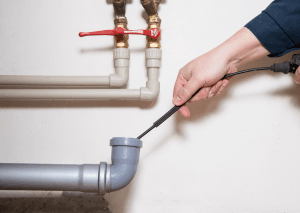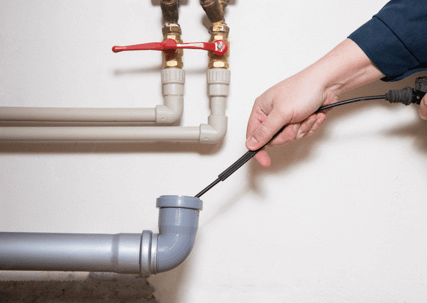At R.S. Andrews, we understand that proper maintenance of your plumbing system involves more than just keeping it clean—it also involves effectively draining plumbing lines when needed. Whether it’s for maintenance, repairs, or preparing for colder seasons, draining your plumbing lines is an essential task.
When it comes to draining your plumbing lines, adopting practical methods can ensure a smooth process and prevent potential issues. Here are some steps to effectively drain your plumbing system:

Turn Off Water Supply
When preparing to drain your plumbing system, the first step is identifying the shut-off valves in your home. Depending on the design of your property, there might be different shut-off valves for various parts of your plumbing system. It’s crucial to familiarize yourself with these locations. In cases where you want to stop the entire water supply, you’ll typically need to find the main valve, usually located close to the water meter. Furthermore, there are often two common types of shut-off valves. The first, the gate valve, requires turning a wheel to shut off, and the second, the ball valve, uses a lever for this purpose. Understanding which type of valve your system has and how to operate it is pivotal.
Open Faucets and Valves
Once the water supply is off, the next step is to open the faucets and valves to aid in drainage. This procedure serves two purposes: letting water out and allowing air in, which facilitates more efficient drainage. The latter is particularly important because it can prevent any potential vacuum effect that might inhibit water flow. When approaching this task, always prioritize the faucet or valve situated at the highest point of your house. For homes that span multiple stories, it’s advisable to initiate the process upstairs and then gradually proceed downstairs.
Drain Lowest Point
The crux of the draining process lies in ensuring the plumbing system’s complete drainage. Any residual water can catalyze several problems, from mold growth and corrosion to freezing, which might culminate in burst pipes. Therefore, it’s essential to determine all the drain points within your system. Some configurations might have multiple drain valves, so comprehensive location identification is key to guaranteeing that no water remains in the system.
Outdoor Showers and Faucets
Outdoor fixtures warrant special attention due to their heightened exposure to external climatic conditions. Efficiently draining these fixtures is paramount, especially in preventing ice formation, which can inflict considerable damage. Post-drainage, homeowners might consider either insulating these fixtures or even transitioning to frost-proof models, especially if the residence is in a colder region.
Precautions and Tips
As with any maintenance task, safety is paramount. It’s recommended to use suitable tools such as wrenches or channel locks to guarantee that no harm befalls the valves or faucets. Furthermore, it’s vital to approach the task with caution. Forcing a valve open or closed can be detrimental, and if a valve proves stubborn, it might be indicative of an underlying issue. Lastly, any draining process is bound to interrupt the normal water supply for a duration. Consequently, it’s sagacious to plan the drainage at a time that least affects daily routines like cooking or cleaning. If the draining process is anticipated to be long, storing water in containers for immediate needs or advising residents to wrap up water-reliant tasks before the procedure can alleviate potential inconveniences.
When to Seek Professional Help
For more complex draining tasks or if you’re uncertain about the process, don’t hesitate to reach out to the experts at R.S. Andrews. Our experts team is always ready to offer guidance and assistance. Whether you’re draining your lines as part of winter preparation, repairs, or preventive plumbing maintenance, our team is dedicated to ensuring that the process is carried out effectively and efficiently.
Frequently Asked Questions
How long does it typically take to drain an average home’s plumbing system?
The duration varies depending on the size of the house, the complexity of the plumbing system, and the water flow. However, for an average-sized home, it might take anywhere from 30 minutes to a couple of hours to fully drain the system.
Is it necessary to drain the water heater as well during this process?
Yes, it’s advisable to drain the water heater periodically to remove sediment buildup. However, the draining process for the water heater is separate from regular plumbing lines, and specific instructions should be followed.
Can leftover water in the plumbing system cause mold or mildew growth?
Residual water in pipes can potentially contribute to mold or mildew growth, especially if there’s stagnant water in areas of the plumbing system that aren’t regularly used. Regular drainage and flushing can prevent such issues.
If I notice discolored water after the drainage process, is that a cause for concern?
Discolored water can occasionally occur after the system is drained and then refilled. This discoloration is often due to sediment being dislodged during the process. Running the water for a few minutes should clear it out. If the discoloration persists, it may be worth consulting with a professional.
Is there a specific time of year that’s best for draining plumbing lines?
While plumbing lines can be drained anytime maintenance or repairs are necessary, many homeowners choose to do this as a preventive measure before winter to avoid frozen pipes. However, it’s also good practice to consider drainage before major seasonal changes, ensuring your plumbing remains in optimal condition.
At R.S. Andrews, we emphasize the importance of proper plumbing maintenance, including draining lines when necessary. By following these straightforward methods, you can ensure that your plumbing lines are efficiently emptied, whether you’re preparing for winter, conducting repairs, or maintaining your plumbing system.
For personalized advice, professional assistance, and plumbing services, reach out to us. We’re dedicated to helping you maintain a functional and efficient plumbing system.

